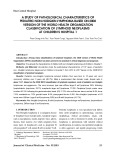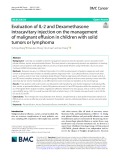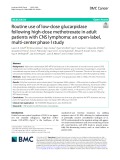
Malignant lymphoma
-
The differential diagnosis between primary mesenteric lymphoma and others peritoneum diseases such as peritoneal carcinomatosis, malignant primary peritoneal mesotheliomas, tuberculous peritonitis, sarcomatosis, diffuse peritoneal leiomyomatosis or benign splenosis, constitutes a major problem in imaging techniques.
 5p
5p  viling
viling
 11-10-2024
11-10-2024
 3
3
 1
1
 Download
Download
-
Non-Hodgkin lymphoma is a malignant disease of lymphoid tissue (lymph nodes, lymphoid organs such as nasopharynx, tonsils, digestive tract, spleen, thymus, bone marrow, etc) which originates from many types of lymphocytes such as progenitor B cell, progenitor T cell, mature B cell or mature T cell. To evaluate the characteristics of children with non-Hodgkin lymphomas at Children’s Hospital 1.
 7p
7p  vinatisu
vinatisu
 29-08-2024
29-08-2024
 0
0
 0
0
 Download
Download
-
This article reports a case of primary thyroid lymphomain a 62 - year - old female patientto showsome clinical and pathological features of primary thyroid lymphomaand review theliterature.
 6p
6p  vinatisu
vinatisu
 29-08-2024
29-08-2024
 2
2
 0
0
 Download
Download
-
The patient, a 22-year-old female, was diagnosed with diffuse large B-cell lymphoma (an aggressive non-Hodgkin’s lymphoma). The patient had completed 6 cycles of R-CHOP (from March 2018 to July 2018). After that, the patient was re-examined regularly monthly (manifested with moderate and hypochromic anemia, bone marrow aspiration was negative for malignancy).
 4p
4p  vinatisu
vinatisu
 29-08-2024
29-08-2024
 4
4
 1
1
 Download
Download
-
Currently, no available coherent management protocol exists for pediatric cancers associated with pleural effusion, ascites, and pericardial efusion. This study aimed to retrospectively present our experience in treating pediatric cancer patients with pleural effusion, ascites, and pericardial efusion using interleukin-2 (IL-2) and dexa‑ methasone (DEX) intracavitary injections.
 8p
8p  vielonmusk
vielonmusk
 21-01-2022
21-01-2022
 10
10
 0
0
 Download
Download
-
It is important to confirm CD30 expression in T-cell lymphoma cases, but immunohistochemical staining for CD30 is not commonly performed and no comparison has been done between the results of flow cytometry (FCM) and immunohistochemical staining for CD30.
 12p
12p  vielonmusk
vielonmusk
 21-01-2022
21-01-2022
 14
14
 0
0
 Download
Download
-
Adult sporadic Burkitt lymphoma (BL) is a rare but highly aggressive subtype of lymphoma which lacks its own unique prognostic model. Systemic inflammatory biomarkers have been confirmed as prognostic markers in several types of malignancy. Our objective was to explore the predictive value of pretreatment inflammatory biomarkers and establish a novel, clinically applicable prognostic index for adult patients with sporadic BL.
 11p
11p  vielonmusk
vielonmusk
 21-01-2022
21-01-2022
 16
16
 1
1
 Download
Download
-
High-dose methotrexate (HD-MTX) has broad use in the treatment of central nervous system (CNS) malignancies but confers significant toxicity without inpatient hydration and monitoring. Glucarpidase is a bacterial recombinant enzyme dosed at 50units (u)/kg, resulting in rapid systemic MTX clearance.
 10p
10p  vielonmusk
vielonmusk
 21-01-2022
21-01-2022
 15
15
 1
1
 Download
Download
-
Classical Hodgkin lymphoma has unique clinical and pathological features and tumour tissue is characterized by a minority of malignant Hodgkin Reed–Sternberg cells surrounded by inflammatory cells. In the present study, we report that the Hodgkin lymphoma-derived cell line L1236 has high expression of 15-lipoxygenase-1 and that these cells readily convert arachidonic acid to eoxin C4, eoxin D4and eoxin E4.
 13p
13p  galaxyss3
galaxyss3
 07-03-2013
07-03-2013
 35
35
 4
4
 Download
Download
-
Among the subspecialties of internal medicine, medical oncology may have had the greatest impact in changing the practice of medicine in the past four decades, as curative treatments have been identified for a number of previously fatal malignancies such as testicular cancer, lymphomas, and leukemia. New drugs have entered clinical use for disease presentations previously either untreatable or amenable to only local means of therapy, such as surgery and irradiation.
 104p
104p  vanass
vanass
 01-04-2011
01-04-2011
 62
62
 9
9
 Download
Download
-
The diagnosis of Hodgkin's disease is established by review of an adequate biopsy specimen by an expert hematopathologist. In the United States, most patients have nodular sclerosing Hodgkin's disease, with a minority of patients having mixed-cellularity Hodgkin's disease. Lymphocyte-predominant and lymphocyte-depleted Hodgkin's disease are rare. Mixed-cellularity Hodgkin's disease or lymphocyte-depletion Hodgkin's disease are seen more frequently in patients infected by HIV (Fig. 105-11).
 5p
5p  thanhongan
thanhongan
 07-12-2010
07-12-2010
 82
82
 4
4
 Download
Download
-
Rare patients with localized early stage mycosis fungoides can be cured with radiotherapy, often total-skin electron beam irradiation. More advanced disease has been treated with topical glucocorticoids, topical nitrogen mustard, phototherapy, psoralen with ultraviolet A (PUVA), electron beam radiation, interferon, antibodies, fusion toxins, and systemic cytotoxic therapy. Unfortunately, these treatments are palliative. Adult T Cell Lymphoma/Leukemia Adult T cell lymphoma/leukemia is one manifestation of infection by the HTLV-I retrovirus.
 5p
5p  thanhongan
thanhongan
 07-12-2010
07-12-2010
 75
75
 3
3
 Download
Download
-
Anaplastic Large T/Null Cell Lymphoma: Treatment Treatment regimens appropriate for other aggressive lymphomas, such as diffuse large B cell lymphoma, should be utilized in patients with anaplastic large T/null cell lymphoma, with the exception that the B cell–specific antibody, rituximab, is omitted. Surprisingly, given the anaplastic appearance, this disorder has the best survival rate of any aggressive lymphoma. The 5-year survival is 75%.
 5p
5p  thanhongan
thanhongan
 07-12-2010
07-12-2010
 70
70
 3
3
 Download
Download
-
Because a number of patients with diffuse large B cell lymphoma are either initially refractory to therapy or relapse after apparently effective chemotherapy, 30–40% of patients will be candidates for salvage treatment at some point. Alternative combination chemotherapy regimens can induce complete remission in as many as 50% of these patients, but long-term disease-free survival is seen in ≤10%.
 5p
5p  thanhongan
thanhongan
 07-12-2010
07-12-2010
 60
60
 2
2
 Download
Download
-
Evaluation of an adequate biopsy by an expert hematopathologist is sufficient to make a diagnosis of follicular lymphoma. The tumor is composed of small cleaved and large cells in varying proportions organized in a follicular pattern of growth (Fig. 105-7). Confirmation of B cell immunophenotype and the existence of the t(14;18) and abnormal expression of BCL-2 protein are confirmatory. The major differential diagnosis is between lymphoma and reactive follicular hyperplasia. The coexistence of diffuse large B cell lymphoma must be considered.
 5p
5p  thanhongan
thanhongan
 07-12-2010
07-12-2010
 76
76
 4
4
 Download
Download
-
Patients with follicular lymphoma have a high rate of histologic transformation to diffuse large B cell lymphoma (5–7% per year). This is recognized ~40% of the time during the course of the illness by repeat biopsy and is present in almost all patients at autopsy. This transformation is usually heralded by rapid growth of lymph nodes—often localized—and the development of systemic symptoms such as fevers, sweats, and weight loss.
 5p
5p  thanhongan
thanhongan
 07-12-2010
07-12-2010
 74
74
 4
4
 Download
Download
-
B Cell Chronic Lymphoid Leukemia/Small Lymphocytic Lymphoma: Treatment Patients whose presentation is typical B cell CLL with no manifestations of the disease other than bone marrow involvement and lymphocytosis (i.e., Rai stage O and Binet stage A; Table 105-7) can be followed without specific therapy for their malignancy. These patients have a median survival 10 years, and some will never require therapy for this disorder.
 5p
5p  thanhongan
thanhongan
 07-12-2010
07-12-2010
 81
81
 4
4
 Download
Download
-
Evaluation of patients with MALT lymphoma follows the pattern (Table 105-11) for staging a patient with non-Hodgkin's lymphoma. In particular, patients with gastric lymphoma need to have studies performed to document the presence or absence of H. pylori infection. Endoscopic studies including ultrasound can help define the extent of gastric involvement. Most patients with MALT lymphoma have a good prognosis, with a 5-year survival of ~75%. In patients with a low IPI score, the 5-year survival is ~90%, while it drops to ~40% in patients with a high IPI score.
 5p
5p  thanhongan
thanhongan
 07-12-2010
07-12-2010
 76
76
 4
4
 Download
Download
-
Table 105-10 Clinical Characteristics of Patients with Common Types of Non-Hodgkin's Lymphomas (NHL) Dis ease edian Age, years M Fre quency in tage S B one B Gastro intestinal Survi Children Male I/II vs Sympt Marro Tract III/IV, oms, % % w Involvement, ving 5 years Involve % ment, % B 6 Rar 9 3 7 3 cell chronic lymphocyt ic leukemia/ small lymphocyt ic lymphoma 5 e 3 vs 91 3 2 1 Ma ntle cell 3 6 e Rar 4 2 0 vs 80 8 2 4 6 9 7 lymphoma Ext ranodal marginal zone cell lymphoma of MALT B 0 6 e Rar 8 6 7 vs 33 9 1 4 1 50 4 type Fol licular lymphoma 9 ...
 5p
5p  thanhongan
thanhongan
 07-12-2010
07-12-2010
 73
73
 3
3
 Download
Download
-
Chronic lymphocytic leukemia. The peripheral white blood cell count is high due to increased numbers of small, well-differentiated, normal-appearing lymphocytes. The leukemia lymphocytes are fragile, and substantial numbers of broken, smudged cells are usually also present on the blood smear. If the primary presentation is lymphadenopathy and a lymph node biopsy is performed, pathologists usually have little difficulty in making the diagnosis of small lymphocytic lymphoma based on morphologic findings and immunophenotype.
 6p
6p  thanhongan
thanhongan
 07-12-2010
07-12-2010
 74
74
 2
2
 Download
Download
CHỦ ĐỀ BẠN MUỐN TÌM
































